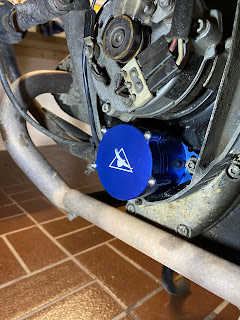This year marks the 50th anniversary of the publication of "Zen and the Art of Motorcycle Maintenance; an Inquiry into Values" by Robert Pirsig.
I first read this waiting for a train in 1982. I'd completed a long bicycle ride and had a day to kill waiting for the train home. On that reading only the frame story and bits of the philosophy made sense. With subsequent readings (seven to date) I came to understand and put into context the philosophy that the book was written to convey. The book has a broad description of Pirsig's Metaphysics of Quality and many side trips into his ideas around motorcycle maintenance and life in general.
My approach to bike maintenance was influenced by Pirsig from that first reading. I was at that point reading Richard Bach's books about maintaining his own biplanes, so the approach of working on machines as well as riding/flying them was already inground. Pirsig's book gave greater depth and thought to the process of working on machines. When I purchased my first motorbike in 1985 my maintenance of it was a natural extension of my work on push bikes and the influence continued. At this point 40 years later I don't know which of the ideas Pirsig and I share I got from him, and which ones he confirmed.
He subsequently wrote a sequel, "Lila; an Inquiry into Morals" (1991), not as packed with ideas as the first book but useful as an elaboration of some of the ideas. His widow Wendy Pirsig edited a collection of his writings "On Quality; an Inquiry into Excellence" published 2022.
The last pages of the book describe a happy moment in the ride where he and his son Chris, sitting pillion, ride south to San Francisco:
The cycle swings into each curve effortlessly, banking so that our weight is alwasys down through the machine no matter what its angle is with the ground. The way is full of flowers and surprise views, tight turns one after another so that the whole world rolls and pirouettes and rises and falls away.
Rich air and strange perfumes from the flowers of the trees and shrubs enshroud us. Inland now the chill is gone and the heat is upon us again. It soaks through my jacket and clothes and dries out the dampness inside. The gloves which have bene dark-wet have started tor turn light again. It seems like I've been bone-chilled by that ocean damp for so long I've forgotten what the heat is like.
The road continues to twist and wind through the trees. It upswings around hairpins and glides into new scenes one after another around and through brush and then out into the open spaces where we can see canyons stretch away below.
The description suggests the "flow" state of Mihaly Csikszentmihalyi, the sublime sense of timelessness and absorption where one is fully engaged in a activity that is challenging, but not too challenging. In Pirsig's metaphysics this is the experience of Dynamic Quality, as opposed to Static Quality, where one categories and explains things.
A broad arc connects the mystical experiences of William James (1899) with the peak experiences of Abraham Maslow (1964), the dynamic quality of Pirsig (1974) and the flow of Csikszentmihalyi (1990). Broadly James recognised that these experiences were not solely in the domain of religion but occur also in meditative and drug-affected states. Maslow recognised that they were more likely when one was in a good place, where the lower levels of one's hierarchy of needs were met. Pirsig supplied the metaphysical structure within which the experience could be understood. And Csikszentmihalyi supplied a detailed road map indicating what things predisposed an individual to these experiences and how we can make them more common.
Recently a website was established to promote and coordinate celebration of the anniversary.
There is an active facebook group ZMM Quality.
After Pirsig's death his bike and various associated items, including his leather jacket and tools, were donated to the Smithsonian Institution. On April 15 the bike will be put on display.
A 50th Anniversary edition of ZMM is to be published 13 February.


















